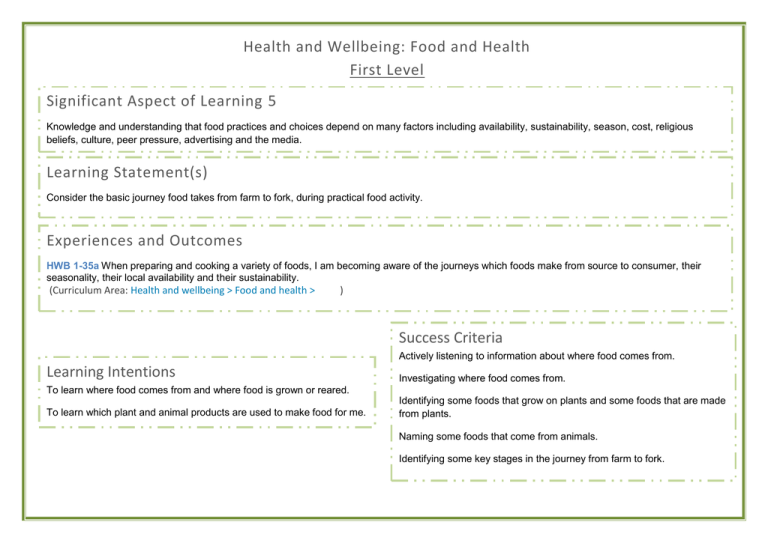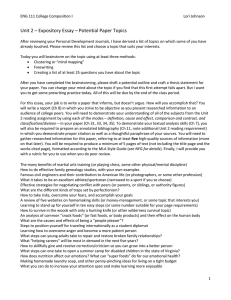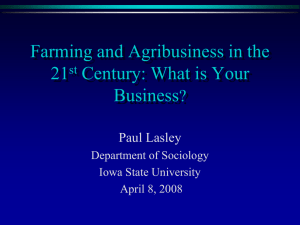Health and Wellbeing: Food and Health Significant Aspect of Learning 5
advertisement

Health and Wellbeing: Food and Health First Level Significant Aspect of Learning 5 Knowledge and understanding that food practices and choices depend on many factors including availability, sustainability, season, cost, religious beliefs, culture, peer pressure, advertising and the media. Learning Statement(s) Consider the basic journey food takes from farm to fork, during practical food activity. Experiences and Outcomes HWB 1-35a When preparing and cooking a variety of foods, I am becoming aware of the journeys which foods make from source to consumer, their seasonality, their local availability and their sustainability. (Curriculum Area: Health and wellbeing > Food and health > ) Success Criteria Actively listening to information about where food comes from. Learning Intentions Investigating where food comes from. To learn where food comes from and where food is grown or reared. To learn which plant and animal products are used to make food for me. Identifying some foods that grow on plants and some foods that are made from plants. Naming some foods that come from animals. Identifying some key stages in the journey from farm to fork. Exploring and Understanding… Learning Intentions To learn where food comes from and where food is grown or reared. Knowledge & Understanding and Skills development: Visit to a farm Farmer visit to the class Trip to the Botanic Gardens to see plants growing Talk from Quality Meat Scotland Independent and paired research SSPCA workshop about animal welfare Actively listening to information about where food comes from. A visit to the class by a farmer provided the children with an opportunity to learn from someone with relevant, real-life experience. The children showed they can listen to and observe information about food origins on the farm. They were able to ask relevant questions to deepen their understanding and could verbally name some sources of food, both plants and animal. Reflecting upon learning… Comments from the teacher: Farmer Visit to class: “The opportunity to talk to a real farmer and ask questions really helped the children’s understanding of what happens on a farm.” Botanics Visit: “The class had the opportunity to explore plants, plant their own and learn about the plant cycle. Skills that they developed included: collecting information, note taking, gathering samples, and following instructions to then plant their own seeds.” Investigating where food comes from. A visit by the class to St. Andrews Botanic Gardens provided the children with an opportunity to explore a range of plants in a Skills:investigation collecting information, note natural setting. Through and discussion, the taking, samples, following instructions children were able togathering explain that some plants produce foods like to then fruit and vegetables plant and that others used to make cereals, their ownare seeds. bread and things like sugar and coffee. Identify some foods that grow on plants. Hands on exploration of animal and plant products allowed the children to explore the texture of wool, hay and wheat. They were able to ask appropriate questions, listen to explanations, and could then identify the wheat as being used to create food for humans, and the hay as food for animals. The activity deepened the children’s understanding of some wider uses of the things that are grown and collected on a farm. Learning Intentions To learn which plant and animal products are used to make food for me. Knowledge & Understanding and Skills development: Collecting samples from plants. Collecting plant samples Describing the texture of plant and animal products. Making connections between plants and their uses. Showing Understanding in a Range of Ways… Identify some foods that grow on plants. Identify some food items that are made from plants. The children show, by selecting only images of foods that come from plants, they have an awareness of the journey that some foods make from farm to fork. The children are able to match foods to the plants they originate from and can, with support link these to the countries in which they grow. They are able to contribute to a class discussion about why some foods can’t grow in certain climates. Identifying some key stages in the journey from farm to fork… The children make connections with previous learning about seasonal changes and consolidate the understanding they have gained through investigations in the classroom and through real-life connections (farm visit, farmer interviews etc.). By creating a ‘Farmers Wheel’ they show that they can name some of the things that happen on the farm in each season to ensure that food is sent on its journey from farm to fork. “I learned to milk a cow.” “Cows get milked two times a day. ”My good learning is the [milking] machine and how it works.” Understanding where food comes from… The children are able to draw their favourite meal to strengthen their understanding that all of the food they eat comes from either a plant or an animal. By labelling some of the food on the plate and explaining where it originates from, they show that they know and understand that food comes from plants and animals and can, for an increasing range of foods, say which ones. , explain whichinplants and animals. Plants grown the class by the children are used as a stimulus for art. Making Interdisciplinary links with Art and how plants grow, the children are able to demonstrate, through their drawings, their knowledge that some foods are grown above and some below the ground (roots and shoots). Challenging Thinking to Deepen Understanding… Identify where food comes from At the start of their farm to fork topic, the children demonstrate – through peer discussions and a matching activity – their existing knowledge of which foods come from plants and which ones from animals. They are able to explain their existing knowledge and use this to identify the next steps in their learning. Identify where food comes from and how we know it is safe to eat. An Inspector from the SSPCA was invited to talk to the class and help them to understand more about farm animal welfare. She explained to the children that it is important for us to know where our food comes from and to ensure that the animals we eat are healthy and treated fairly. Following a discussion, the children played top trumps to further develop their understanding about farm animal welfare. They were then able to show that they could make the link between animals, the food they eat, and the needs the animals have to stay healthy, by playing a true/false card game with a partner – also allowing for peer assessment of learning. Applying Learning in Practical Situations… Following investigation of a range of plants and their uses at St. Andrews Botanic Gardens, the children planted seeds to take back to school and grow. They were able to explain that the seeds would grow leaves (cress and mustard) that they would then be able to pick and use when cooking other foods to enhance the flavours. Name some foods that come from animals. Quality Meat Scotland spent time with the class talking about meats reared in Scotland and the health benefits of eating a balanced diet – including good quality red meat. The children then prepared and ate a wrap made with Scottish beef. They are able to explain that the beef they have eaten was reared on a farm similar to the one they visited earlier. Health and Wellbeing: Food and Health First Level Significant Aspect of Learning 5 Knowledge and understanding that food practices and choices depend on many factors including availability, sustainability, season, cost, religious beliefs, culture, peer pressure, advertising and the media. Learning Statement(s) Discuss and understand how advertising may influence their food choices. Experiences and Outcomes HWB 1-37a I am discovering the different ways that advertising and the media can affect my choices. (Curriculum Area: Health and wellbeing > Food and health > ) Learning Intentions To learn about the influence of advertising and how it affects our choices. To extend my learning about persuasive techniques and how they are used in adverts. Success Criteria Identify some methods companies use to encourage you to eat their food. Create my own poster using persuasive techniques. Investigating and Understanding… "McDonalds advert would encourage you to eat it as it shows healthy farm stuff." "The way people on adverts talk make you want to eat their food." Learning Intentions To learn about the influence of advertising and how it affects our choices. Knowledge & Understanding and Skills development: "Sometimes they show you how healthy things are and show you all the nice meat and milk." "Even though some food is unhealthy I would eat it because the poster makes it look delicious." Listening to/watching food adverts on TV and Radio. Analysing advertising posters. Creating own posters to show learning about advertising techniques. Identify some methods companies use to encourage you to eat their food. The children watched a range of adverts on the TV, listened to some adverts on the radio and looked at advertising leaflets and posters. Through observation and discussion they were able to explain how advertisers try to influence them and also to show their ideas by annotating food posters. Identify some methods companies use to encourage you to eat their food. Comments from annotated food posters show that the children can identify some strategies used to influence them and persuade them to eat certain foods. Identify some methods companies use to encourage you to eat their food. The children are able to discuss food adverts with a partner, identify slogans and target product, and make personal observations about the effect the advert has on them and how it would influence their decisions. Applying Knowledge… Learning Intentions To extend my learning about persuasive techniques and how they are used in adverts. "I would drink Innocent Smoothies because it looks like a superhero." Knowledge & Understanding and Skills development: Create posters advertising different foods. Use a range of techniques to influence people to eat the foods being advertised. "Adverts tell you the stuff’s good for you." "Using cartoon characters and famous pop stars and stuff make us want to try it. We think it’s cool." "McDonalds’ toys encourage you to go there."




